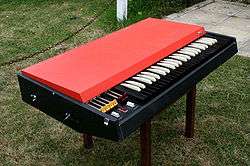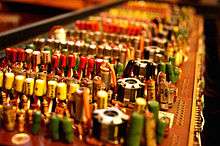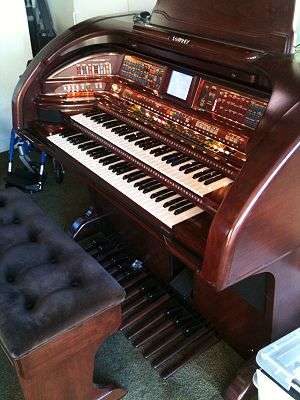Vox Continental
The Vox Continental is a transistorized combo organ that was introduced in 1962 by the musical equipment manufacturer Vox. Having a characteristic bright but thin, breathy sound, the "Connie", as it was affectionately known, was designed for touring musicians. It was also intended to replace heavy tonewheel organs, such as the revered Hammond B3.

While that goal was not entirely accomplished, the Continental became a very popular instrument, especially with garage bands, and it can be heard in many 1960s and 1970s hit singles by The Beatles, The Animals, The Doors, Elvis Costello, and The Velvet Underground. After being phased out of production in the early 1970s, the organ remained a sought-after combo organ by enthusiasts. In September 2017, Korg released a workstation-style keyboard named in honor of the Vox Continental and highlighting the particular Continental organ sound.[1]
Description

The Continental had two basic designs, each with its own variations. They were the single manual Continental, and the dual manual model called the Vox Continental II in England and the Vox Super Continental in Italy. Vox Continentals were initially manufactured in the Jennings Musical Instruments plant in Dartford, Kent, UK, and by Vox Sound in Erith, Kent. Reportedly the English factories could not keep up with demand for VOX amplifiers and organs, and in 1964, a licensing deal was signed between Jennings and the Thomas Organ Company in the USA.
In 1992, Korg acquired Vox.[2] Since then new products carrying the trademark Vox have been primarily for the guitar player, and the Korg trademark appears on keyboards.
The Continental is visually striking, with atypical features for a keyboard instrument. The most obvious one is its reverse-colored keys (black naturals and white sharps) similar to a harpsichord. Then the chrome Z-shaped bolt-on leg stand assembly and bright vermilion (in some models grey) top made for a distinctive and handsome piece of equipment. The Vox Continental used six slider-type, metered volume controls called drawbars instead of the stop-tab rocker switches seen on other combo organs. Two of the drawbars controlled the voices (flute and reed tones), and three of the other four controlled the footages (in reference to ranks of pipes on a pipe organ, but were essentially successive octave controls. The lower the footage number, the higher the octaves were pitched (8 foot being one octave higher than 16 foot etc.), the last of the four controlling a mixture of four higher pitches. There was a single-speed, single intensity vibrato, but the Continental had no other special effects or bass pedalboard. Its simplicity was appreciated by many players.
Single-manual Continentals
Although they had similar tones and appearance, Vox Continentals came from four different factories. The first were UK models built by Jennings Musical Industries, or JMI, in Dartford, Kent, England. Later UK models were built by Vox Sound in Erith, Kent.
For a short time following Thomas Organ's 1964 licensing deal with VOX, single-manual Continentals were built in the US at the Thomas Organ factory at 8345 Hayvenhurst Avenue in Sepulveda, California. There were reportedly about 300 of these 301-H ("Hayvenhurst") organs made, mostly from April through June 1966. Production was then moved to the EME factory in Italy.
Hayvenhurst Continentals are distinguished by their unique tone generator boards (sourced from Thomas' line of home organs), wooden keys covered in plastic, a feature shared by their Jennings-made forebears with a very nice "touch", and use of American standard hardware, which was a good deal more robust than the metric hardware used on the Italian-made Continentals, which make up roughly 80% of all Continental production. Hayvenhurst Continentals comprise only 3% of total single-manual production, with the balance being early UK-built units. Italian models can be discerned from UK and US models by their flimsy plastic keys, white and black (instead of cream and maroon) drawbars and crossed stand braces. Some think that the sound of the Italian versions was thinner than that of its UK and US counterparts, and that UK and US Continentals, as far as appearance and sound quality, were essentially identical (even though the US-built Continentals were somewhat different electronically from their English predecessors). The build quality and reliability of the US-built Continentals are held to be superior to the other three variations.
Derivatives
In the late 1960s and the early 1970s, various derivatives and variations came along, including the Vox Jaguar, Vox Corinthian and the last of the single manual Continentals, the Vox Continental '71.
Dual-manual Continentals
The UK had the Continental II and 300, and Italy had the Super Continental. Both had plastic keys and were available with and without percussion. Confusingly, the UK version with percussion (which only came with a grey and not red top) was known as the "Super II".
The dual manual had its developments and variants. These included the Vox Continental 300, which introduced reverb and presets, and the Continental Baroque, which included different voices on the upper manual (including banjo, harpsichord and piano), as well as internal amplification.
Artists
The instrument was commonly heard in rock and roll of the 1960s, especially as played by Alan Price of The Animals, Mike Smith of The Dave Clark Five and Ray Manzarek of The Doors. Famous songs that feature the Vox Continental include:
- 1960s
- "The House of the Rising Sun" (1964) and "Don't Let Me Be Misunderstood" (1965) by The Animals
- "Because" and "Glad All Over" (1964) by The Dave Clark Five
- "California Sun" (1964) by The Rivieras
- "Time Is on My Side" (1964) by The Rolling Stones
- "She's About a Mover" (1965) by the Sir Douglas Quintet
- "Pushin' Too Hard" (1965) by The Seeds
- "Woman" (1965) by The Zombies
- "Keep on Dancing" (1965) by The Gentrys
- "I'm Down" and "Think for Yourself" (1965) by The Beatles
- "96 Tears" (1966) by Question Mark and the Mysterians
- "I'm a Believer" and "(I'm Not Your) Steppin' Stone" (1966) by The Monkees
- "Hungry" (1966) by Paul Revere and The Raiders
- "(We Ain't Got) Nothin' Yet" (1966) by the Blues Magoos
- "Working My Way Back to You" (1966) by The Four Seasons
- "Absolutely Sweet Marie" (1966) and "If You Gotta Go, Go Now" (1967) by Bob Dylan, who also played the Connie on the 1979 tour for his album Slow Train Coming
- "Light My Fire" and "When the Music's Over" (1967) by The Doors
- "The Rains Came" (1966) and "Mendocino" (1968) by the Sir Douglas Quintet
- "Brown Eyed Girl" (1967) by Van Morrison
- "The Letter" and "Neon Rainbow" (1967) by The Box Tops
- "Sister Ray" (1968) and "What Goes On" (1969) by The Velvet Underground
- "In-A-Gadda-Da-Vida" (1968) by Iron Butterfly
Following the 1960s the Vox Continental played a significant role in generating keyboard sound of the 1970s and early 1980s new wave and punk rock. The Continental was used extensively by prodigy Steve 'Nieve' (aka Steve Nason), keyboard player for Elvis Costello & The Attractions, and by Mike Barson of 2-Tone group Madness. It was also used by 2-Tone founder Jerry Dammers of The Specials.
- post-1960s
- "Yo-Yo" and "Down by the Lazy River" (1972) by the Osmonds
- "Don't Stop" (1977) by Fleetwood Mac
- "Don't Do Me Like That" (1979) by Tom Petty and the Heartbreakers
- "Lay Your Love on Me" (1979) by Racey
- "Some of My Lies Are True (Sooner or Later)" and "Don't Ever Tell Me That You Love Me" (1980) by Huey Lewis and the News
- "Stand" (1988) and "Radio Song" (1991) by R.E.M.
- "Why Does the Sun Shine? (The Sun Is a Mass of Incandescent Gas)" (1993) and "Boss of Me" (2000) by They Might Be Giants
- "Past the Mission" (1994) by Tori Amos
- "I Will Buy You a New Life" (1997) by Everclear
- "Budapest" (2014) by George Ezra[3]
- "Beryl" (2015) by Mark Knopfler
More recently in popular music culture, the organist Rhys Webb, of the UK garage band The Horrors can be seen using the Continental, as can Sam Steinig of Mondo Topless and Walt Martin of The Walkmen, while Kenny Howes of Atlanta psyche-pop group Orange Hat used a Super Continental.[4] Benmont Tench of Tom Petty and the Heartbreakers has also frequently used a '65 Continental since the early days of Mudcrutch. Singer-songwriter Grayson Hugh featured a Continental on his song "Angel of Mercy" from his 2010 Swamp Yankee Records release "An American Record".
Two Vox Continental organs are seen in the promo video for "Summer in the City" by The Lovin' Spoonful, played by John Sebastian and bassist Steve Boone, although the signature keyboard line is played on a Hohner Pianet. A Vox Continental is seen in use by Eric Harvey of Spoon in the music video for their song "Sister Jack". The Vox can also be seen in several televised appearances by The Four Seasons, played by Bob Gaudio on such performances of "I've Got You Under My Skin" and "Working My Way Back to You". The Vox Continental organ can also be seen in numerous televised appearances of The Dave Clark Five played by lead singer Mike Smith on shows such as The Ed Sullivan Show and Shindig!
Alex Turner also used the Vox Continental for Arctic Monkeys song "505", the closer of second album Favourite Worst Nightmare, as well as on third album Humbug and "Crying Lightning" b-side "Red Right Hand".
The former organist of The Moons, Tom Warmsley, uses a single manual Vox Continental, and another former member, James Edward Bagshaw, uses a Vox Continental 300.
References
- "VOX Continental". VOX Amplification Ltd. Retrieved 13 February 2019.
- http://www.voxamps.com/history/
- http://headphonedaydreams.wordpress.com/2014/07/27/now-88/
- Orange Hat's video for Liquid Me, featuring the Vox Super Continental.
External links
- The history of the Vox Continental in detail: www.reinout.nl
- Combo Organ Heaven
- Vox Showroom
